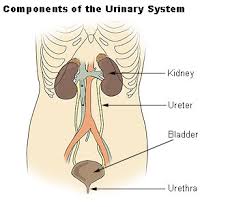kidneys
In humans, the excretory system consists of a pair of kidneys, one pair of ureters, a urinary bladder and a uretha.
Shape and Size of Kidneys:- Kidneys are reddish brown, bean-shaped structures situated between the levels of last thoracic and third lumber vertebra close to the dorsal inner wall of the abdominal cavity.
Each kidney of an adult human measures 10-12 cm in length, 5-6 cm in width, 2-3 cm in thickness with an average weight of 120-170 g. Left kidney is little higher than the right one because of more space being occupied by the liver on right side. So, only in human beings the right kidney is slightly below the left. But in other mammals, e.g., the left kidney is below the right

Towards the centre of the inner concave surface of the kidney is a notch called hilum through which ureter. Blood vessels and nerves pass.
Kidney is covered by 3 protective layers which are as follows:-
- Renal capsule:– It is innermost, tough protective cover made up of white fibrous connective tissue, with few elastic fibres and few muscles.
- Adipose Capsule:– it is the middle cover involving adipose tissue and acts as shock absorber.
- Renal Fascia:- It is the outermost fibrous cover linking it with the abdominal wall.
As the kidneys are fused with the body wall on the dorsal side, peritoneal cover is present only on the ventral side. This arrangement is called retroperioneal arrangement.
Internal structure:- Inner to the hilum is a broad funnel-shaped space called the renal pelvis with projections called Calyces. The outer layer of kidney is a tough capsul. Inside the kidney, there are two zones, an outer cortex and an inner medulla. The medulla is divided into a few conical masses (medullary pyramids) projecting into the calyces (sing: Calyx).
The cortex extends in between the medullary pyramids as renal columns called Columns of Bertini.
Each renal pyramid has a broad base towards the cortical side. Apex is pointed and is called renal papilla. 1-2 renal papillae project into a cavity called minor calyx, which join up and form major calyces.Interstitial fluid of medulla region has a higher osmotic concentration equal to some 1200 mOsm/L. due to higher quality of two solutes, NaCl and urea. Cortical region close to medulla is called juxtamedullary area. The major calyces open into a broad funnel-shaped structure called renal pelvis placed inner ti hilum. It is lined by transitional epithelium. It leads to ureta.

Ureters:– They are a pair of fine whitish distensible muscular tubes of 25-30 cm length, about 3 mm in diameter. Ureters develop from hilum part of the kidneys, descend along the abdominal wall, bend obliquely inwards and upwards to open in to urinary bladder in the region of trigone by oblique slits, one on each side. Wall of the ureter has 3 coats- external adventitla, middle circular and inner longitudinal.
Ureters are always undergoing peristalsis which helps in passing urine from kidney to urinary bladder.
Urinary Bladder:- It is median pyriform sac which varies in shape, size and position according to the amount of urine contained in it. The fully distended bladder becomes ovoid in outline. Bladder has three parts- apex,funds or body and neck. Body has a triangular area called trigone. It has openings of ureters and an internal urethral orifice. Neck region possesses two sphincters, involuntary internal sphincter and voluntary external sphincter. Neck leads into urethra.
Wall of urinary bladder consists of three coats- outer adventitia, middle muscular and inner mucosa. The muscle present in the middle muscular coat is also called detrusor muscle because it takes part in destruction or pushing down of urine. Muscular coat has involuntary circular muscles in the middle and involuntarylongitudinal muscles on its either side. Mucosa
has loose connective tissue towards the side of muscular layer and transitional epithelium or urothelium towards lumen. Adventitia is formed of soft connective tissue. During the micturition,both the sphincters undergo relaxation. Cerebral cortex direct the sphincter to relax and person undergoes urination. Wall of urinary bladder is innervated by both sympathetic and parasympathetic nervous system.
Urethra:- It is present only in mammals. It starts from the neck of the urinary bladder and opens outside the body. In female, it is short (2-4 cm), straight and concerned with the release of urine through an aperture called urethral orifice or urinary aperture present in the vulva in front of the vaginal aperture. However, in males, it is quite long (20 cm), passes through the prostate gland, cowper’s glands and penis. It is concerned with the release of urine as well as semen (sperms+ glandular secretion) through an aperture called urinogenital aperture at the tip of the penis